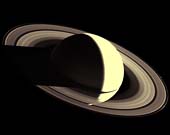|
COMETS EARTH JUPITER KUIPER BELT MARS MERCURY METEORITES NEPTUNE OORT CLOUD PLUTO SATURN SOLAR SYSTEM SPACE SUN URANUS VENUS ORDER PRINTS
PHOTO CATEGORIES SCIENCEVIEWS AMERICAN INDIAN AMPHIBIANS BIRDS BUGS FINE ART FOSSILS THE ISLANDS HISTORICAL PHOTOS MAMMALS OTHER PARKS PLANTS RELIGIOUS REPTILES SCIENCEVIEWS PRINTS
|
Related Document
Download Options
Four days after its encounter with Saturn, Voyager 1 looked back on the planet from a distance of more than 5.3 million kilometers (3.3 million miles). This view of Saturn has never been seen by an earth based telescope, since the earth is so close to the Sun only the sunlit face of Saturn can be seen. This viewing geometry, which shows Saturn as a crescent, is never achieved from Earth. The Saturnian rings, like the cloud tops of Saturn itself, are visible because they reflect sunlight. The translucent nature of the rings is apparent where Saturn can be seen through parts of the rings. Other parts of the rings are so dense with orbiting ice particles that almost no sunlight shines through them and a shadow is cast onto the yellowish cloud tops of Saturn, which in turn, casts a shadow across the rings at right. The black strip within the rings is the Cassini Division, which contains much less orbiting ring material than elsewhere in the rings. This image is Copyright © 2002 by Calvin J. Hamilton. Any commercial/for-profit use of this image needs to be addressed to Calvin J. Hamilton. |
||||||||||||||||||||||||||||||||||||||
